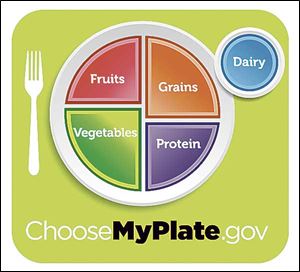
What's on your plate?
7/2/2011
Nowadays, instead of a food pyramid, the new USDA icon at ChooseMyPlate.gov is designed to look like a plate with a space for each of the five food groups: grains, vegetables, fruit, protein, and dairy. Vegetable gardeners conveniently can apply the nutritional advice to "make half your plate fruits and vegetables."
How many plant parts can you add to your salad? Leaves are a traditional salad base whether it's lettuce, spinach, or other fresh greens such as baby chard, kale, arugula, or mitzuna. Many of these plants prefer cool weather, so you can start making plans for your fall vegetable garden. Wash and slice some fruit of the plant, shred some roots, chop some stems, and top the leaves with edible flowers and seeds.
Vegetable gardeners have the advantage of access to all plant parts. Although many plants only have one edible part (other plant parts are not tasty or desirable), quite a few plants provide more than one part to eat. If you like roasted pumpkin seeds, you probably will enjoy roasted seeds from other winter squash. If you usually eat only the roots or leaves of beets and turnips, grow some extra to try sampling the other plant part.
Don't think you like the roots of plants like beets and turnips? Try a mixture of roasted root vegetables. Although this is a wonderful fall and winter recipe, don't discount it for the summertime. Instead of heating up the oven, try making it outside on the grill:
Heat oven (or grill) to 450 degrees.
Scrub 4 pounds of different root vegetables (carrots, beets, turnips, potatoes, parsnips, onions, etc.) under running water, cut off tops and root ends. Cut into 1-inch cubes.
Toss root vegetables with 3 tablespoons of vegetable or olive oil and spread on a baking sheet.
Roast for 15 minutes.
Stir vegetables, turn heat down to 375 degrees and continue to roast another 10 minutes.
Add 3 tablespoons chopped fresh herbs (rosemary, oregano, or sage) and five minced garlic cloves, stir again, and cook until vegetables are soft when pierced with a knife (about 15 to 30 minutes).
MyPlate recommends: Keep raw, cut-up vegetables handy for quick snacks. Too hot to cook? Most vegetables that traditionally are cooked can often be eaten raw. Add green beans, sliced summer squash, or peas to the veggie tray. Slaws can be made from a large variety of raw shredded vegetables and even fruit.
The Dietary Guidelines for Americans recommends: Eat red, orange, and dark green vegetables, such as tomatoes, sweet potatoes, and broccoli, in main and side dishes. It's never too early to make plans for next year's vegetable garden. If you are not growing some of these fruits and vegetables right now, make a point to taste test these plants by visiting your local farmers' market. For more ideas on preparing and enjoying a wide variety of vegetables, visit lucas.osu.edu, the collection of cook books at the library, or use your favorite restaurant items or local farmer's markets for inspiration. Plan to join OSU Extension, Lucas County and Toledo GROWs at 10 a.m. July 9 at Oneida Garden (between Cherry and Lagrange Streets) in Toledo to discuss From Plant to Plate.
Patrice Bowers-Barker is a program assistant with OSU Extension Lucas County. If you have questions, call the OSU Extension Master Gardener Volunteer Horticultural Hotline at 419-578-6783. Volunteers are on hand Monday, Wednesday, and Friday from 10 a.m. to 1 p.m. Questions also may be e-mailed to mghotline@ag.osu.edu and possibly answered in a future Plant to Plate column.